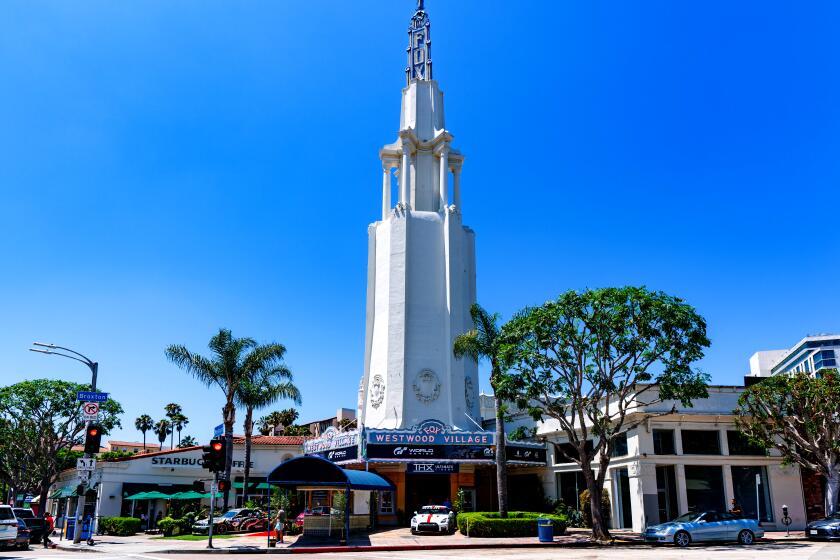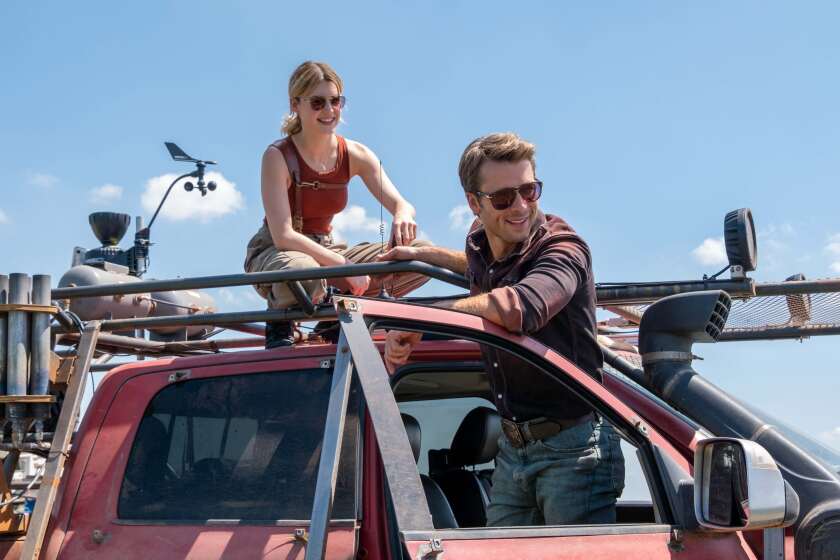Ward Kimball, 88; Key Disney Animator
Ward Kimball, the most colorful and eccentric of the Nine Old Men, the key group of Disney artists whose work set the standard by which all animation is judged, died Monday at Arcadia Methodist Hospital in Arcadia. He was 88 and died of natural causes.
In addition to his work on the classic features “Snow White and the Seven Dwarfs,” “Pinocchio,” “Fantasia,” “Dumbo,” “The Three Caballeros,” “Melody Time,” “Cinderella,” “Alice in Wonderland” and “Mary Poppins,” Kimball directed the Oscar-winning shorts “Toot, Whistle, Plunk and Boom” (1953) and “It’s Tough To Be a Bird” (1969).
“Ward is one man who works for me that I am willing to call a genius,” Diane Disney Miller quoted her father as saying in “The Story of Walt Disney.”
Born on March 4, 1914, in Minneapolis, Kimball attended the Santa Barbara School of the Arts, intending to become a painter/illustrator. In March 1934, an instructor persuaded him to submit a portfolio to the Walt Disney Studio in Los Angeles. Kimball later told an animation historian, John Canemaker, that he had insisted that the studio accept or reject him on the spot, declaring “I don’t have enough money to buy gas to come back!”
Kimball began work at Disney a month later and remained there until he retired in 1973. He received his first solo assignment in 1935, animating a grasshopper-musician in the “Silly Symphony” “Woodland Cafe.” Kimball quickly rose through the ranks to become a supervising or directing animator.
He spent months animating a sequence for “Snow White” in which the dwarfs eat the soup Snow White has prepared for them; he was ready to quit when it was cut from the film.
He made an appointment to see Walt Disney, but Disney began talking about “Pinocchio” and how he wanted Kimball to animate the cricket who would serve as the title character’s conscience. Recalling how deftly Disney had defused a problem on one film by building his enthusiasm for the next one, Kimball said, “Walt was a salesman!”
The design of Jiminy Cricket proved difficult. Kimball explained, “Normally, an artist caricatures an animal by learning to draw it correctly--then the caricature becomes a simple problem of degree. But a cricket looks like a cross between a cockroach and grasshopper. I did 12 or 14 versions, and gradually cut out all the insect appendages. I ended up with a little man who looks like Mr. Pickwick, but with no ears, no nose and no hair. The audience accepts him as a cricket because the other characters say he is.”
Kimball ranked as among his best work the animation of the jaunty but sympathetic crows who give Dumbo confidence in the form of a “magic feather.” A jazz fan and a musician, he found the crows “exactly what I had in mind for animation: I realized you had to create a personality for each one, just as Walt had always insisted that the Dwarfs had to have seven distinct personalities with clean demarcations between them.”
But the madcap finale of “The Three Caballeros” (1945) is generally considered Kimball’s finest and most characteristic work. Donald Duck, Jose Carioca and Panchito zip around the screen, performing the title number as props appear and disappear. The song ends with Panchito holding the last note for an impossible 20 seconds, while Donald and Jose scramble for ways to silence him. Director Clyde Geronimi objected to Kimball’s illogical cutting within the sequence: Donald may exit to the right and re-enter from the left.
But Disney liked the effect and, as Kimball noted, “that was all that mattered.”
In 1948, Kimball formed a Dixieland jazz band, The Firehouse Five Plus Two, with other Disney artists, including Frank Thomas, another of the Nine Old Men, on piano. They began playing for noon dances on studio sound stages, with Kimball leading and playing trombone. The Firehouse Five soon graduated to nightclubs, including the Mocambo in Hollywood, appeared on the Milton Berle and Ed Sullivan television shows, and recorded 12 albums (which have been reissued on CD). In his later years, Kimball received fan mail--and royalty checks--for his work with a group that disbanded when the members tired of “the late hours, the extra effort and the frenzy.”
After working on the spoiled cat, Lucifer, in “Cinderella,” Kimball animated Tweedledum and Tweedledee, the Mad Hatter and the March Hare and the Cheshire Cat in “Alice in Wonderland” (1951). Although he found the finished film disappointing, Kimball said, “I didn’t realize it at the time, but the Cheshire Cat is the maddest thing in the whole picture because he was underplayed. He didn’t move much--he’d finish a word and accent it with a quick flipping back and forth of the tail, then he’d go into that grin. I didn’t realize it was so mad.” Kimball’s increasingly stylized approach to animation didn’t fit into the personality-driven features of the ‘50s, and Disney assigned him to direct two short films for release in 1953. “Adventures in Music: Melody” was the studio’s first 3-D cartoon; “Toot, Whistle, Plunk and Boom,” Disney’s first CinemaScope short, won an Oscar for Best Cartoon. He directed a second Oscar-winner in 1969, the 22-minute “It’s Tough To Be a Bird,” which featured stylized visuals and irreverent humor.
He followed the shorts with three one-hour programs for the “Disneyland” TV series: “Man in Space” (1955), “Man and the Moon” (1955) and “Mars and Beyond” (1957). Kimball described these off-beat mixtures of animation, live action, fact, fiction and humor as “the creative high point of my career.” He later worked on the live-action musical “Babes in Toyland” (1961), and produced and directed 43 episodes of the syndicated series “The Mouse Factory” (1972-73).
Kimball retired from the Disney Studio in 1973, but emerged for special assignments. In 1978, he served as the conductor on the “Birthday Special,” a whistle-stop train tour from Union Station in Los Angeles to New York City in celebration of Mickey Mouse’s 50th birthday. He also helped to design the 1982 “World of Motion” attraction for the Epcot Center in Florida.
These projects combined two of Kimball’s great loves: animation and railroads. In 1938, he bought a full-sized 1881 steam locomotive, which he restored and installed with other cars and engines on a track in the backyard of his San Gabriel home: the Grizzly Flats Railroad. He amassed an extraordinary collection of model trains and helped to fire Walt Disney’s interest in railroading. In 1992, he donated some of his rolling stock to the Orange Empire Railway Museum in Riverside.
An irreverent, iconoclastic man, Kimball was an exceptional caricaturist: During the late ‘30s, he and his assistant Walt Kelly, the future creator of “Pogo,” drew countless gag cartoons about each other. The same quirky spirit pervaded his animation, as Canemaker concluded in his recent book, “Walt Disney’s Nine Old Men & the Art of Animation”:
“Ward Kimball’s contribution to Disney animation was unique; it represents an exciting alternative approach to character animation and narrative--open, fresh, and experimental. It reflects the man himself, who had within him the spirit of an independent filmmaker.”
Kimball is survived by his wife of 66 years, Betty; three children, John Kimball, Kelly Kimball and Chloe Lord; five grandchildren; and two great-grandchildren.
Services will be private with plans for a remembrance to be announced later. In lieu of flowers, the family suggests that donations be made to any of the following: Berklee College of Music (Boston); Ward Kimball Memorial Fund (California Institute of the Arts, 24700 McBean Parkway, Valencia, Calif.); the Cartoon Art Museum (San Francisco); or the Orange Empire Railroad Museum (Perris, Calif.)
More to Read
Only good movies
Get the Indie Focus newsletter, Mark Olsen's weekly guide to the world of cinema.
You may occasionally receive promotional content from the Los Angeles Times.






